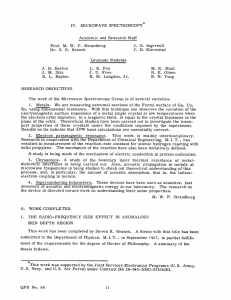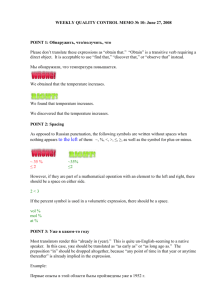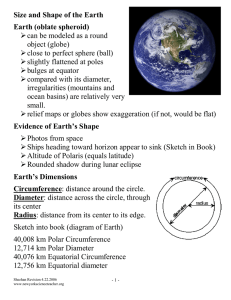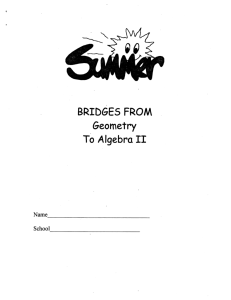v .
advertisement
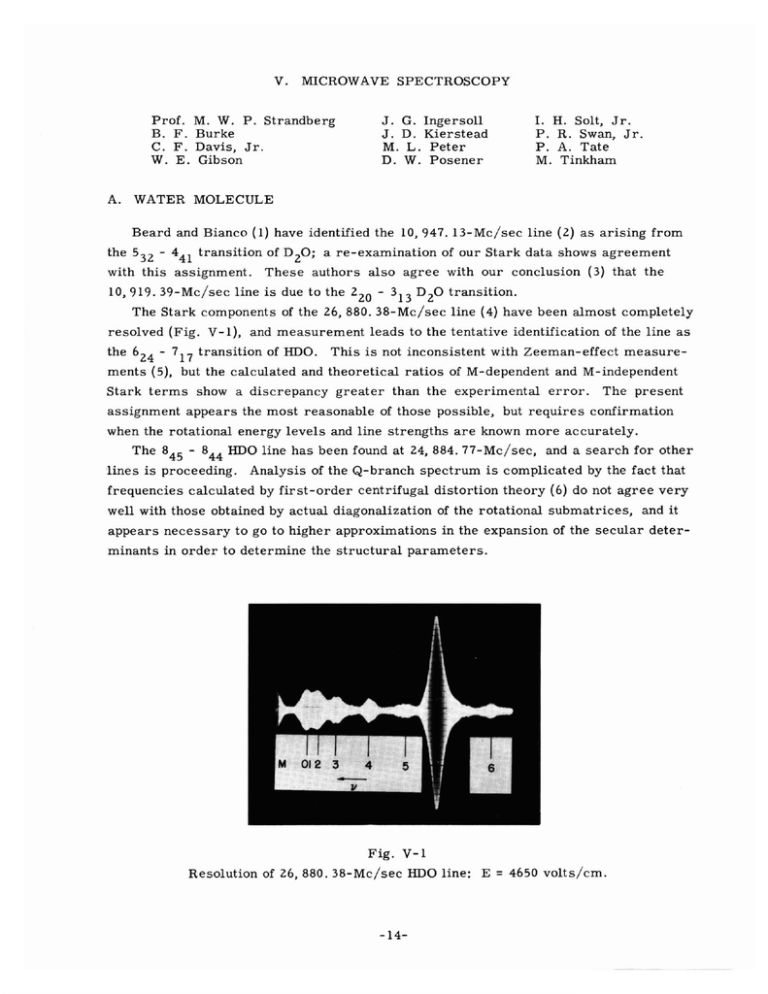
v. Prof. B. F. C. F. W. E. A. MICROWAVE SPECTROSCOPY M. W. P. Strandberg Burke Davis, Jr. Gibson J. G. Ingersoll J. D. Kierstead M. L. Peter D. W. Posener 1. H. Solt, Jr. P. R. Swan, Jr. P. A. Tate M. Tinkham WATER MOLECULE Beard and Bianco (1) have identified the 10,947. 13-Mc/sec line (2) as arising from the 5 32 - 441 transition of D 20; a re-examination of our Stark data shows agreement with this assignment. These authors also agree with our conclusion (3) that the 10,919. 39-Mc/sec line is due to the 220 - 3 13 D 20 transition. The Stark components of the 26,880. 38-Mc/sec line (4) have been almost completely resolved (Fig. V-I), and measurement leads to the tentative identification of the line as the 6 - 7 17 transition of lIDO. This is not inconsistent with Zeeman-effect measure24 ments (5), but the calculated and theoretical ratios of M-dependent and M-independent Stark terms show a discrepancy greater than the experimental error. The present assignment appears the most reasonable of those possible, but requires confirmation when the rotational energy levels and line strengths are known more accurately. The 8 - 8 lIDO line has been found at 24, 884. 77- Mc/sec, and a search for other 45 44 lines is proceeding. Analysis of the Q-branch spectrum is complicated by the fact that frequencies calculated by first-order centrifugal distortion theory (6) do not agree very well with those obtained by actual diagonalization of the rotational submatrices, and it appears necessary to go to higher approximations in the expansion of the secular determinants in order to determine the structural parameters. Fig. V-I Resolution of 26, 880. 38-Mc/sec lIDO line: E = 4650 volts/em. -14- (V. MICROWAVE SPECTROSCOPY) The distortion coefficients of HDO have been recalculated from infrared data, and are in substantial agreement with Lewis' work (7); they are not, however, sufficiently accurate for work in the microwave region. In the I r representation, which is appropriate for this molecule, off-diagonal Rough calculations elements (KIK + 1) and (KIK+ 3) connect rotational submatrices. show their effects can probably be neglected entirely for Q-branch transitions, though they should be taken into account for some P- or R-branch lines (for example, 624 - 717 line). D. W. Posener References 1. C. I. Beard, D. R. Bianco: J. Chem. Phys. 20, 1488, 1952 Quarterly Progress Report, Research Laboratory of Electronic S, 1952, pp. 28-29 2. D. W. Posener: M. I.T. July 15, 3. D. W. Posener: Quarterly Progress Report, Research Laboratory of Electronic S, M. I.T. Oct. 15, 1952, p. 20 4. K. B. McAfee: 5. B. F. Burke: Quarterly Progress Report, Research Laboratory of Electronics, M. I.T. July 15, 1952, pp. 27-28 6. R. E. Hillger, M. W. P. Strandberg: Phys. Rev. 83, 575, E. Bright Wilson, Jr.: J. Chem. Phys. 20, 1575, 1952 7. W. H. Lewis: B. MAGNETIC MOMENT OF S35 Doctoral Thesis, Dept. of Chemistry, Harvard University, 1949 Master's Thesis, Dept. of Physics, M.I.T. 1951; D. Kivelson, 1951 A program has been undertaken, in cooperation with V. W. Cohen of Brookhaven 35 National Laboratory, to measure the magnetic moment of the radioactive isotope S We are planning to make measurements on the hyperfine structure of the J = 1 - 2 transition in 016C12S3 5 . The methods to be used are similar to those used by Eshbach, 33 Hillger, and Strandberg (Phys. Rev. 85, 532, 1952) on the stable isotope S . The first sample was not sufficiently enriched in S35: the strongest component was barely detected, while the weaker components could not be seen with a filtering time-constant The concentration of OCS 3 5 was estimated by comparing line intensity with the intensity of the corresponding absorption of OCS 3 3 in its natural abundance (0. 7 of 3 sec. percent), and the results indicated that the concentration of OCS 3 5 was approximately 0. 1 percent. Work will be resumed when irradiation of a new sample is completed. B. F. Burke -15- (V. C. SPECTROSCOPY) MICROWAVE GENERATION OF HARMONICS IN THE MILLIMETER REGION It has seemed advisable to study rather extensively the generation of harmonics in the millimeter region. The procedure in the past has been to utilize for both harmonic generation and detection the standard Sylvania 1N26 coaxial crystals in designed in this laboratory. a multiplier However, low power output has necessitated the use of a superheterodyne system involving two klystrons, automatic frequency control, forth. and so Therefore, an improved system was sought which would give enough second harmonic power to make feasible a straight detection system. Various methods have been investigated, but the method which is being developed at the present time seems to be a decided improvement over anything used before in this laboratory. This system uses British Ka-band crystals, type VX4107, rectangular in structure, guide. which are approximately 0. 1-inch thick, with windows to fit K a-band These crystals have been used for detecting second harmonic power up to 60, 000 Mc/sec, and have excellent broadband characteristics. The uniformity of the crystals seems to be exceptionally good, all five of the crystals available in this laboratory being consistently good over this region. These crystals are also being used for generation of second harmonics from fundamental frequencies of around 25, 000 Mc/sec and are superior to anything previously investigated. power has been obtained at 50, 000 Mc/sec. Approximately 1 mw of double We are now working to extend our frequency range to 80, 000 Mc/sec. D. P. R. Swan, Jr. The paramagnetic resonance group has been in need of a new magnet. This magnet RESEARCH ON MAGNET DESIGN must be capable of producing fields of the order of 15 kg over a 6-inch pole pieces and approximately 10 kw to 15 kw input. 2. 5-inch gap, using Design began with the sug- gestion of Professor Francis Bitter that a return yoke does not greatly increase the flux in a magnet, provided the iron core pieces are long compared to their diameter. This design is possible because the large cross section of the air-return path compensates for its low permeability. laboratory magnet; This was checked by removing the return path of the old a decrease of 10 percent in maximum field was observed. A model was pieced together from steel shafting 3 inches in diameter and some coils with approximately 3800 turns apiece. Experiments were conducted in which the place- ment and number of these coils, the current through them, the length of the core, the shape of the pole pieces, and the gap spacing were varied. able with other conditions fixed decreased The maximum field attain- slowly with decreasing core length. This decrease could be explained in terms of the assumed expression for the demagnetizing correction -16- MICROWAVE SPECTROSCOPY) (V. D f (L-D) 2 where D is the core diameter and L the core length. (L - D enters, since this is roughly the distance to the center of the distribution of demagnetizing poles.) L/D between 2. 5 and 6 were used and L/D of 3. 5 was decided upon for the full-scale model. It has been our observation that there was a definite saturation effect at fields (measured in the gap) of one-fourth to one-half of the saturation induction of the iron. The maximum field obtainable was approximately inversely proportional to the gap-todiameter ratio (for gap-to-diameter ratios greater than 1:4). This was accounted for by fringing near the gap and saturation of the core occurring about one core diameter behind the edge of the coil closest to the gap. saturated Thus additional windings behind the region could have little effect in the gap. Measurements were made by ballistic means, using two turns of wire around the core (see Fig. V-2). The basic expression for field may be given as B= 1.6X10 where M is the mass of copper, -5 x rMIr P the power input, I the gap length, r the mean radius of the winding, and B the flux density (mks units throughout). total reluctance of the circuit is in the gap. This assumes that the In the experimental model (with gap-to- diameter ratio of 1:4 and L/D of 4) it was found that in the absence of saturation the observed B was approximately one-half of that predicted by the formula. This factor was constant within 5 percent up to fields of 13 kg (in the gap) when the windings were within one diameter of the gap. It fell to about two-thirds of this value at 13 kg when the windings were distributed over 2. 5 diameters. Although it is difficult to give a quantita- SATURATION -- tive prescription for the optimum distribu- COILS I AND 2 TOGETHER 2020COILS I ND 2 TOGETHER tion of windings, certain qualitative concepts seem apparent. The bulk of the windings must be as close to the gap as is consistent COL I 10o _j with reasonable coil diameter. COIL As a working compromise, we plan to use a "two-step" COIL 2 winding with approximately 70 percent of . . the copper within one diameter of the gap and the rest in a thin winding extending back to within about one diameter of the end of Fig. V-2 Flux density as a function of position. There was the same number of ampere turns in each coil. the iron slug (see Fig. V-2). With a typical gap-to-diameter ratio and -17- (V. MICROWAVE SPECTROSCOPY) untapered pole pieces, the field in the gap was observed to be approximately one-half the maximum field in the iron. This could be improved by about 30 percent by tapering the core from a 3-inch to a 2-inch diameter over a length of 2 inches, thus losing over 50 percent of the cross-sectional area. The same reduction in diameter over a shorter length gave less improvement. Drawings for the proposed magnet have been prepared and construction is under way. M. -18- Tinkham, C. F. Davis, Jr., I. H. Solt, Jr.
